Research on the Implementation of a Heat Pump in a District Heating System Operating with Gas Boiler and CHP Unit
Abstract
Featured Application
Abstract
1. Introduction
2. Materials and Methods
2.1. Methods
2.1.1. Control Logic for Technology Prioritisation in DH System Operation
2.1.2. Calculation of Energy Performance Indicators
Eimp,ee = SUM(Econs,ee,HP − Eprod,ee,CHP)
Eexp,ee = SUM(Eprod,ee,CHP − Econs,ee,HP)
2.1.3. Calculation of the CO2 Emissions
2.1.4. Calculation of Costs
2.2. Case Study
2.2.1. System with Gas-Fired Boiler
2.2.2. System with Gas-Fired Boiler and CHP Unit
2.2.3. Systems with a Gas-Fired Boiler, CHP Unit, and HP
2.2.4. Operational Cost Components: Energy, Equipment, and Maintenance
3. Results and Discussion
4. Conclusions
Future Work and Research Outlook
- 1.
- Methodological enhancement through optimisation and hybrid approaches
- 2.
- Advanced financial modelling under dynamic market conditions
- 3.
- Progressive integration into fourth-generation DH paradigms
Author Contributions
Funding
Institutional Review Board Statement
Informed Consent Statement
Data Availability Statement
Conflicts of Interest
Abbreviations
| A | area (m2) |
| C | cost (€) |
| COP | coefficient of performance (-) |
| E | energy (kWh) |
| EP | primary energy (kWh) |
| EPI | primary energy indicator (kWh/m2) |
| f | energy factor (-) |
| SCOP | seasonal coefficient of performance (-) |
| RES | share of renewable energy (-) |
| m | mass (t) |
| CHP | combined heat and power |
| COP | coefficient of performance |
| DH | district heating |
| DHW | domestic hot water |
| GIS | geographic information system |
| GWP | global warming potential |
| HP | heat pump |
| PV | photovoltaic |
| RES | renewable energy sources |
| Subscripts | |
| a | annual |
| B | boiler |
| cons | consumption |
| d | discount |
| ee | electricity |
| em | emission |
| exp | exported |
| g | gas |
| i | energy carrier |
| I | initial investment |
| imp | imported |
| LH | levelized cost of heat |
| nren | non-renewable |
| p | year |
| prod | produced |
| r | discount rate |
| s | system |
| t | total |
| τ | accounting period |
References
- Lund, H.; Werner, S.; Wiltshire, R.; Svendsen, S.; Thorsen, J.E.; Hvelplund, F.; Mathiesen, B.V. 4th Generation District Heating (4GDH). Energy 2014, 68, 1–11. [Google Scholar] [CrossRef]
- Alarnaot Alarnaout, G.; Navarro-Esbrí, J.; Mota-Babiloni, A. Operational, Economic, and Carbon Footprint Feasibility of a Moderately-High-Temperature Heat Pump as an Alternative to Conventional Boilers in Various Scenarios. Energy Convers. Manag. 2024, 309, 118424. [Google Scholar] [CrossRef]
- Požgaj, D.; Pavković, B.; Delač, B.; Glažar, V. Retrofitting of the District Heating System Based on the Application of Heat Pumps Operating with Natural Refrigerants. Energies 2023, 16, 1928. [Google Scholar] [CrossRef]
- Volkova, A.; Krupenski, I.; Pieper, H.; Ledvanov, A.; Latõšov, E.; Siirde, A. Small Low-Temperature District Heating Network Development Prospects. Energy 2019, 178, 714–722. [Google Scholar] [CrossRef]
- Lund, H.; Østergaard, P.A.; Chang, M.; Werner, S.; Svendsen, S.; Sorknæs, P.; Thorsen, J.E.; Hvelplund, F.; Mortensen, B.O.G.; Mathiesen, B.V.; et al. The Status of 4th Generation District Heating: Research and Results. Energy 2018, 164, 147–159. [Google Scholar] [CrossRef]
- Yu, H.; Bergaentzlé, C.; Petrović, S.; Ahlgren, E.O.; Johnsson, F. Combining Techno-Economic Modeling and Spatial Analysis for Heat Planning in Rural Regions: A Case Study of the Holbæk Municipality in Denmark. Smart Energy 2024, 14, 100144. [Google Scholar] [CrossRef]
- Reiter, P.; Poier, H.; Holter, C. BIG Solar Graz: Solar District Heating in Graz—500,000 m2 for 20% Solar Fraction. Energy Procedia 2016, 91, 578–584. [Google Scholar] [CrossRef]
- Popovski, E.; Aydemir, A.; Fleiter, T.; Bellstädt, D.; Büchele, R.; Steinbach, J. The Role and Costs of Large-Scale Heat Pumps in Decarbonising Existing District Heating Networks—A Case Study for the City of Herten in Germany. Energy 2019, 180, 918–933. [Google Scholar] [CrossRef]
- Aste, N.; Caputo, P.; Del Pero, C.; Ferla, G.; Huerto-Cardenas, H.E.; Leonforte, F.; Miglioli, A. A Renewable Energy Scenario for a New Low Carbon Settlement in Northern Italy: Biomass District Heating Coupled with Heat Pump and Solar Photovoltaic System. Energy 2020, 206, 118091. [Google Scholar] [CrossRef]
- Barco-Burgos, J.; Bruno, J.C.; Eicker, U.; Saldaña-Robles, A.L.; Alcántar-Camarena, V. Review on the Integration of High-Temperature Heat Pumps in District Heating and Cooling Networks. Energy 2022, 239, 122378. [Google Scholar] [CrossRef]
- Ommen, T.; Thorsen, J.E.; Markussen, W.B.; Elmegaard, B. Performance of Ultra Low Temperature District Heating Systems with Utility Plant and Booster Heat Pumps. Energy 2017, 137, 544–555. [Google Scholar] [CrossRef]
- Olympios, A.V.; Pantaleo, A.M.; Sapin, P.; Markides, C.N. On the Value of Combined Heat and Power (CHP) Systems and Heat Pumps in Centralised and Distributed Heating Systems: Lessons from Multi-Fidelity Modelling Approaches. Appl. Energy 2020, 274, 115261. [Google Scholar] [CrossRef]
- David, A.; Mathiesen, B.V.; Averfalk, H.; Werner, S.; Lund, H. Heat Roadmap Europe: Large-Scale Electric Heat Pumps in District Heating Systems. Energies 2017, 10, 578. [Google Scholar] [CrossRef]
- Levihn, F. CHP and Heat Pumps to Balance Renewable Power Production: Lessons from the District Heating Network in Stockholm. Energy 2017, 137, 670–678. [Google Scholar] [CrossRef]
- Ommen, T.; Markussen, W.B.; Elmegaard, B. Heat Pumps in Combined Heat and Power Systems. Energy 2014, 76, 989–1000. [Google Scholar] [CrossRef]
- Capone, M.; Guelpa, E.; Verda, V. Optimal Installation of Heat Pumps in Large District Heating Networks. Energies 2023, 16, 1448. [Google Scholar] [CrossRef]
- Helin, K.; Syri, S.; Zakeri, B. Improving District Heat Sustainability and Competitiveness with Heat Pumps in the Future Nordic Energy System. Energy Procedia 2018, 149, 455–464. [Google Scholar] [CrossRef]
- TRNSYS Transient System Simulation Tool. 2013. Available online: https://www.trnsys.com/ (accessed on 15 May 2025).
- Primary Energy Factors for Republic of Croatia. Available online: https://mpgi.gov.hr/UserDocsImages/dokumenti/EnergetskaUcinkovitost/meteoroloski_podaci/FAKTORI_primarne_energije.pdf (accessed on 3 February 2022).
- DIN EN 12831-1:2017-09; Energy Performance of Buildings—Method for Calculation of the Design Heat Load. DIN Media GmbH: Berlin, Germany, 2017.
- DIN 4708-2:1994-04; Zentrale Wassererwärmungsanlagen; Regeln Zur Ermittlung Des Wärmebedarfs Zur Erwärmung von Trinkwasser in Wohngebäuden. DIN Media GmbH: Berlin, Germany, 1994; p. 7.
- The TESS Component Libraries 17; TESS: Madison, WI, USA, 2021.
- Technology Brochure-CHP Units for Heat and Power—Vitobloc; Viessmann GmbH: Allendorf, Germany, 2019.
- Delač, B.; Pavković, B.; Lenić, K.; Mađerić, D. Integrated Optimization of the Building Envelope and the HVAC System in NZEB Refurbishment. Appl. Therm. Eng. 2022, 211, 118442. [Google Scholar] [CrossRef]
- Regulation (EU) 2024/573 of the European Parliament and of the Council of 7 February 2024 on Fluorinated Greenhouse Gases, Amending Directive (EU) 2019/1937 and Repealing Regulation (EU) No 517/2014; 2024. Available online: https://eur-lex.europa.eu/eli/reg/2024/573/oj/eng (accessed on 15 May 2025).
- GEA RTSelect Configuration and Engineering Software, Version 13. 9. 2.; GEA Group: Düsseldorf, Germany, 2025.
- HEP Elektra d.d. National Electricity Tariff Items for Supply the Enterprise Consumers. Available online: https://www.hep.hr/elektra/poduzetnistvo/tarifne-stavke-cijene-1578/1578 (accessed on 24 April 2025).
- Official Gazette of the Republic of Croatia NN RH No. 83/2023—The Act on Amendments to the Law on RES and High-Efficiency Cogeneration. Available online: https://narodne-novine.nn.hr/clanci/sluzbeni/2023_07_83_1298.html (accessed on 24 April 2025).
- Official Gazette of the Republic of Croatia NN RH No. 31/2023—The Regulation on Eliminating Market Disturbances. Available online: https://narodne-novine.nn.hr/clanci/sluzbeni/2023_03_31_531.html (accessed on 24 April 2025).
- Central European Gas Hub. Available online: https://www.cegh.at/en/ (accessed on 24 April 2025).
- National Electricity Operator HEP Elektra d.d. Complex Interconnection to the Medium-Voltage Grid. Available online: https://www.hep.hr/ods/pristup-mrezi/prikljucenje-na-mrezu-28/slozeno-prikljucenje/239 (accessed on 24 April 2025).
- Schaumann, G.; Schmitz, K.W. Kraft-Wärme-Kopplung, 4th ed.; Springer: Berlin/Heidelberg, Germany, 2010. [Google Scholar]
- Famiglietti, J.; Acconito, L.; Arpagaus, C.; Toppi, T. Environmental Life Cycle Assessment of Industrial High-Temperature to Residential Small-Size Heat Pumps: A Critical Review. Energy Convers. Manag. X 2025, 26, 100947. [Google Scholar] [CrossRef]
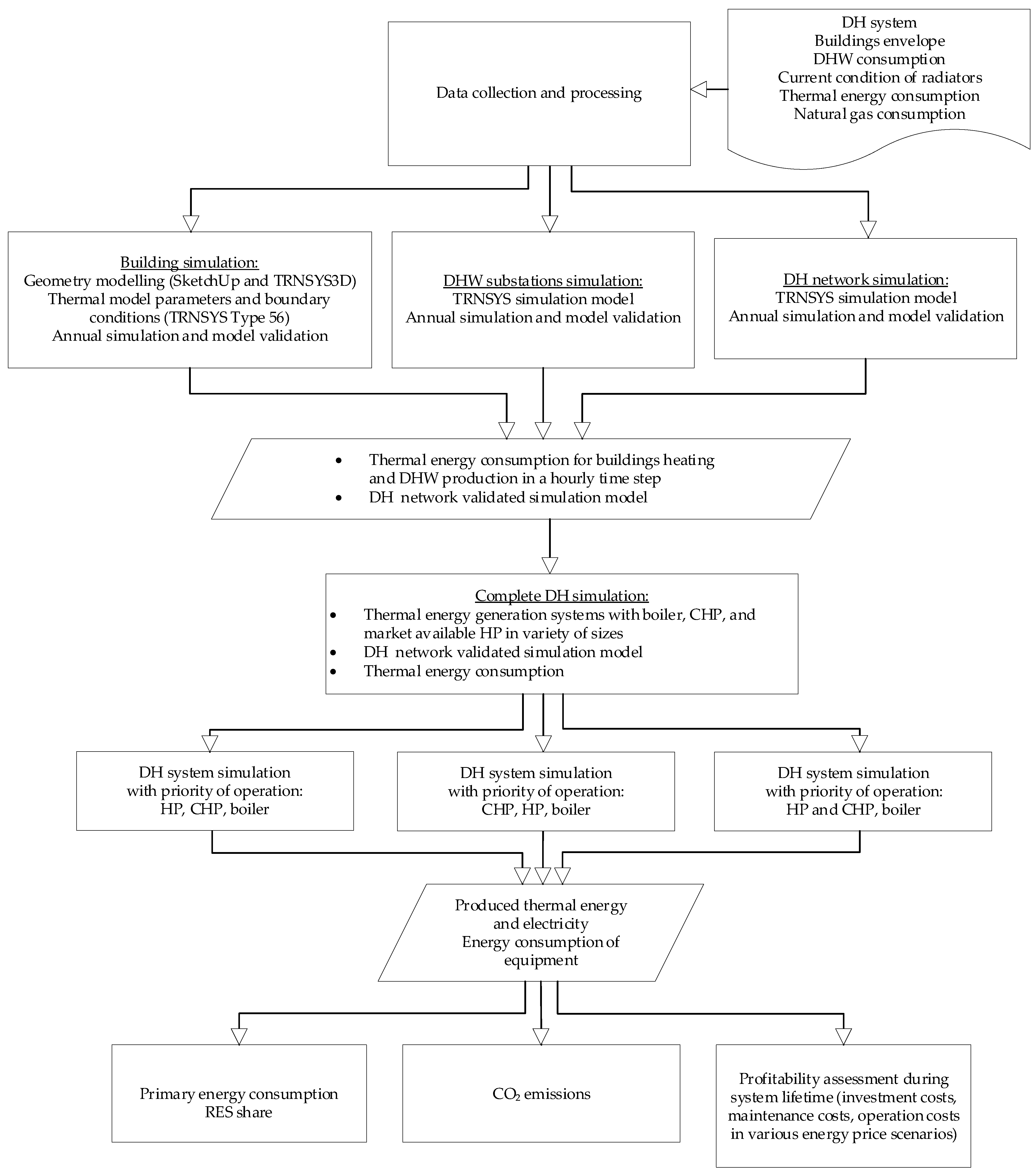

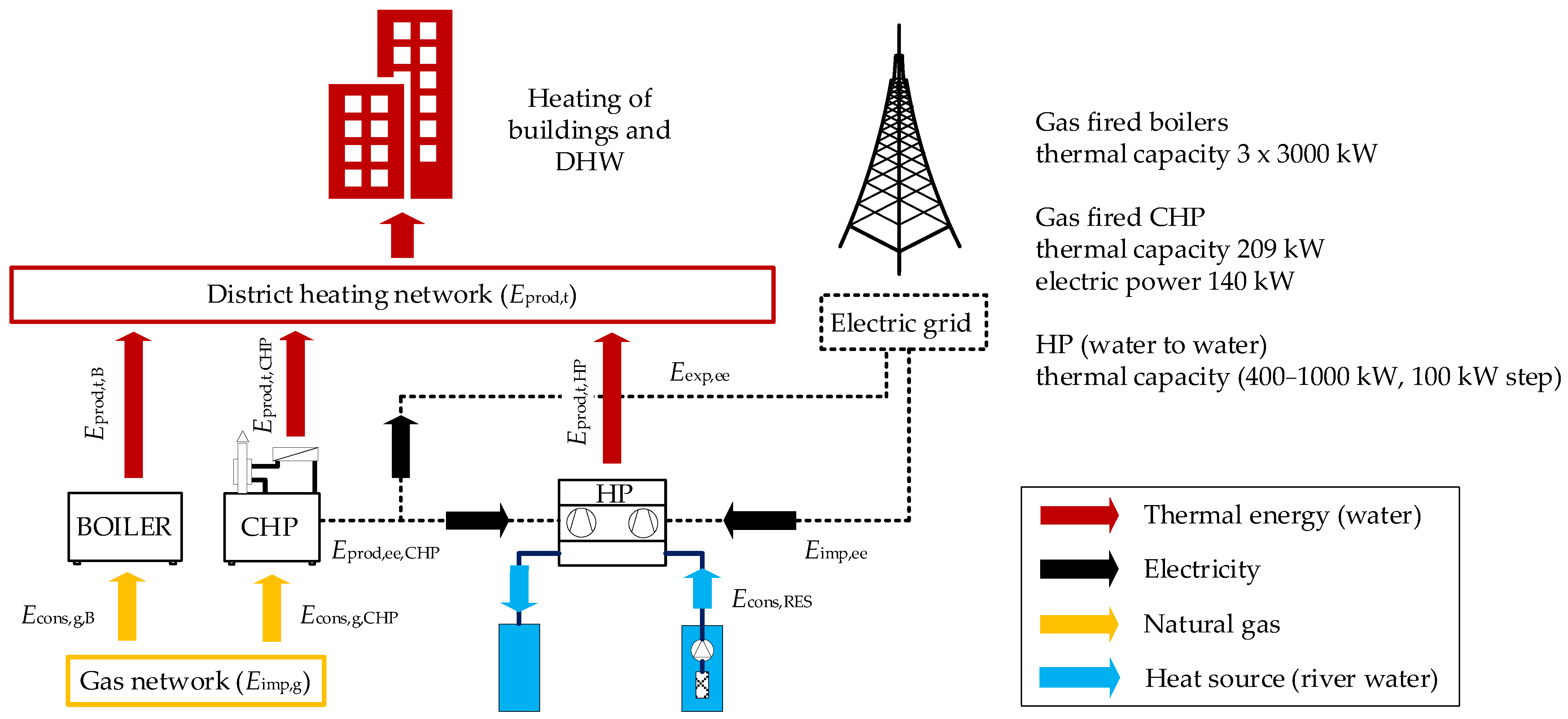
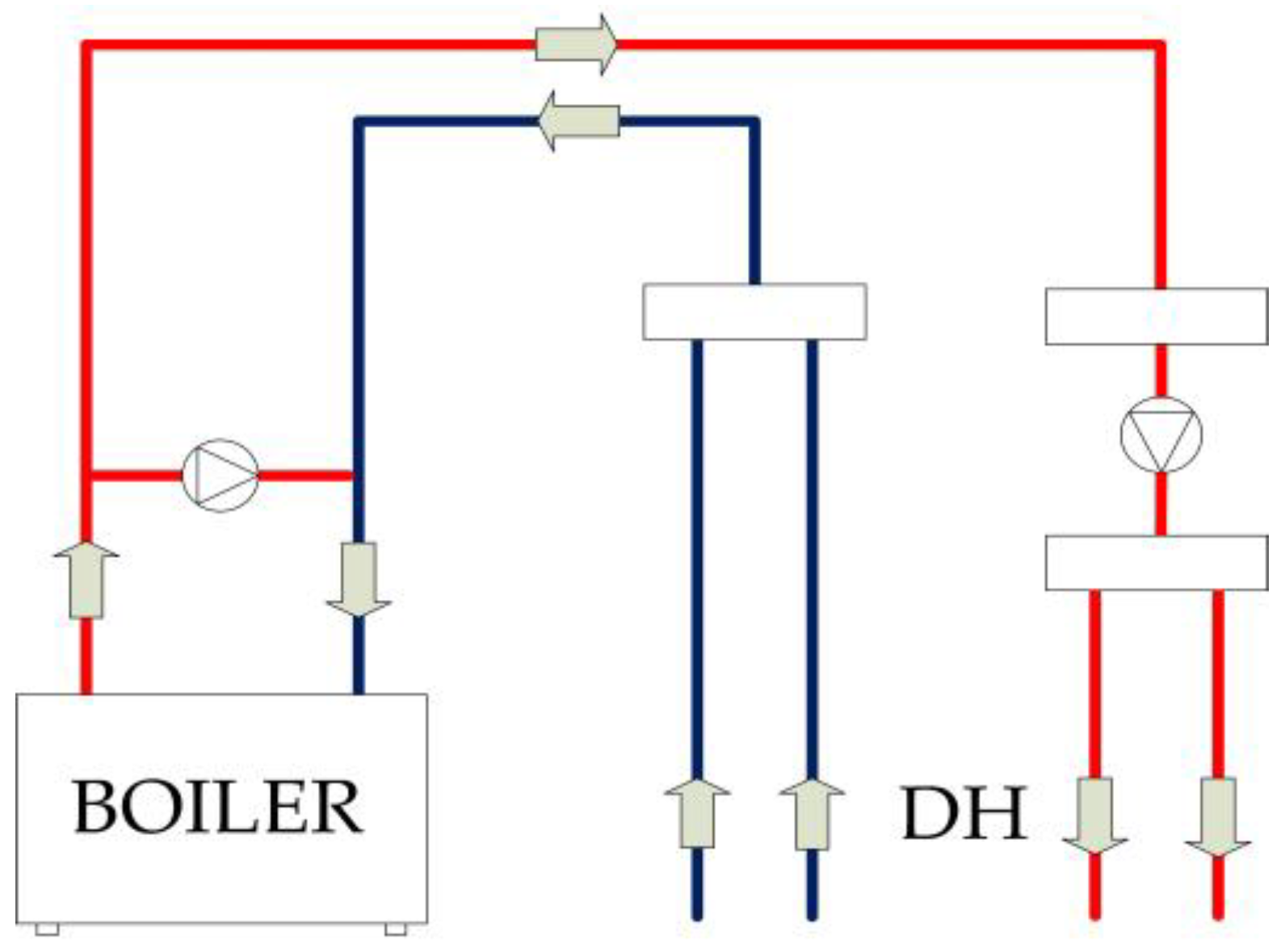
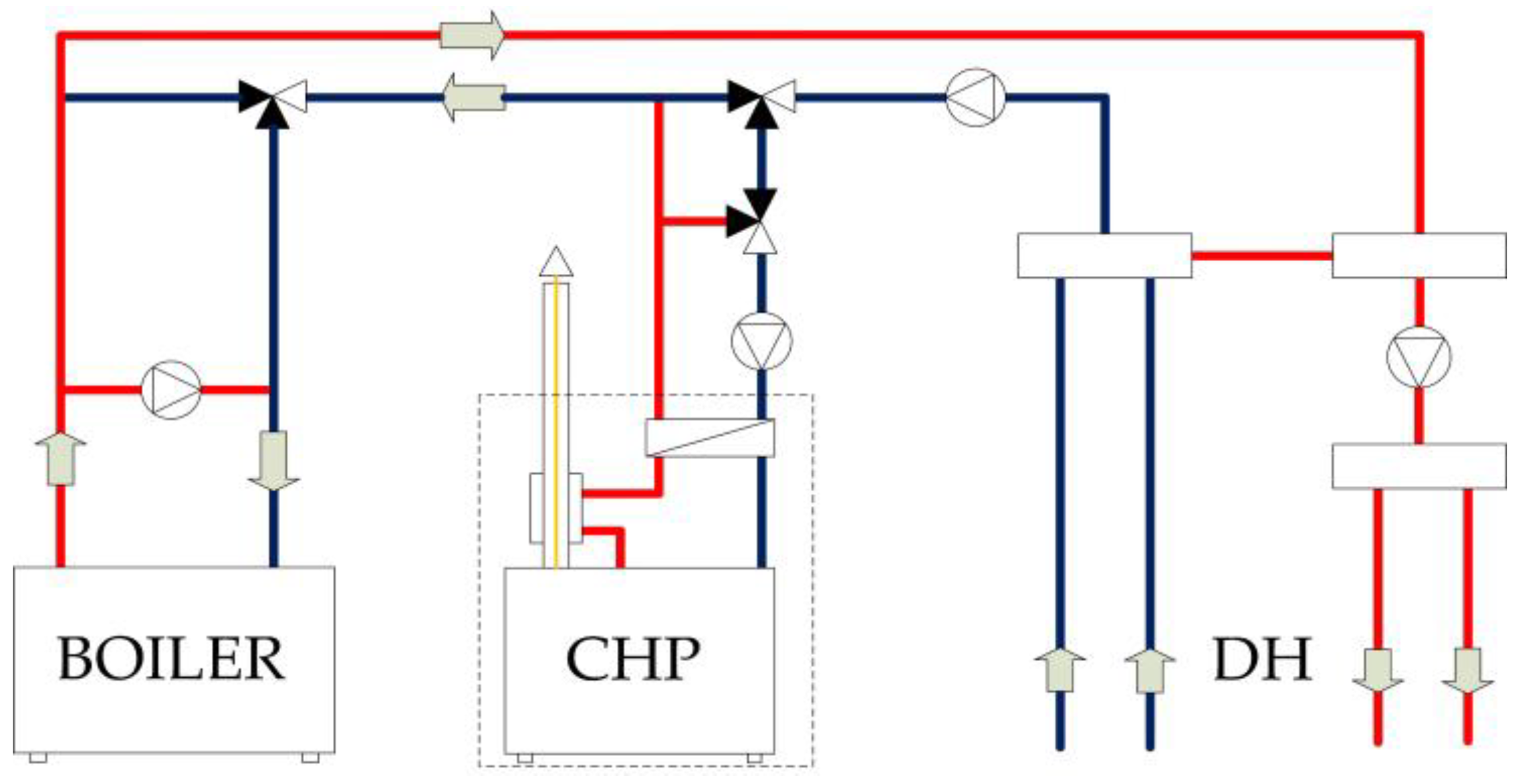
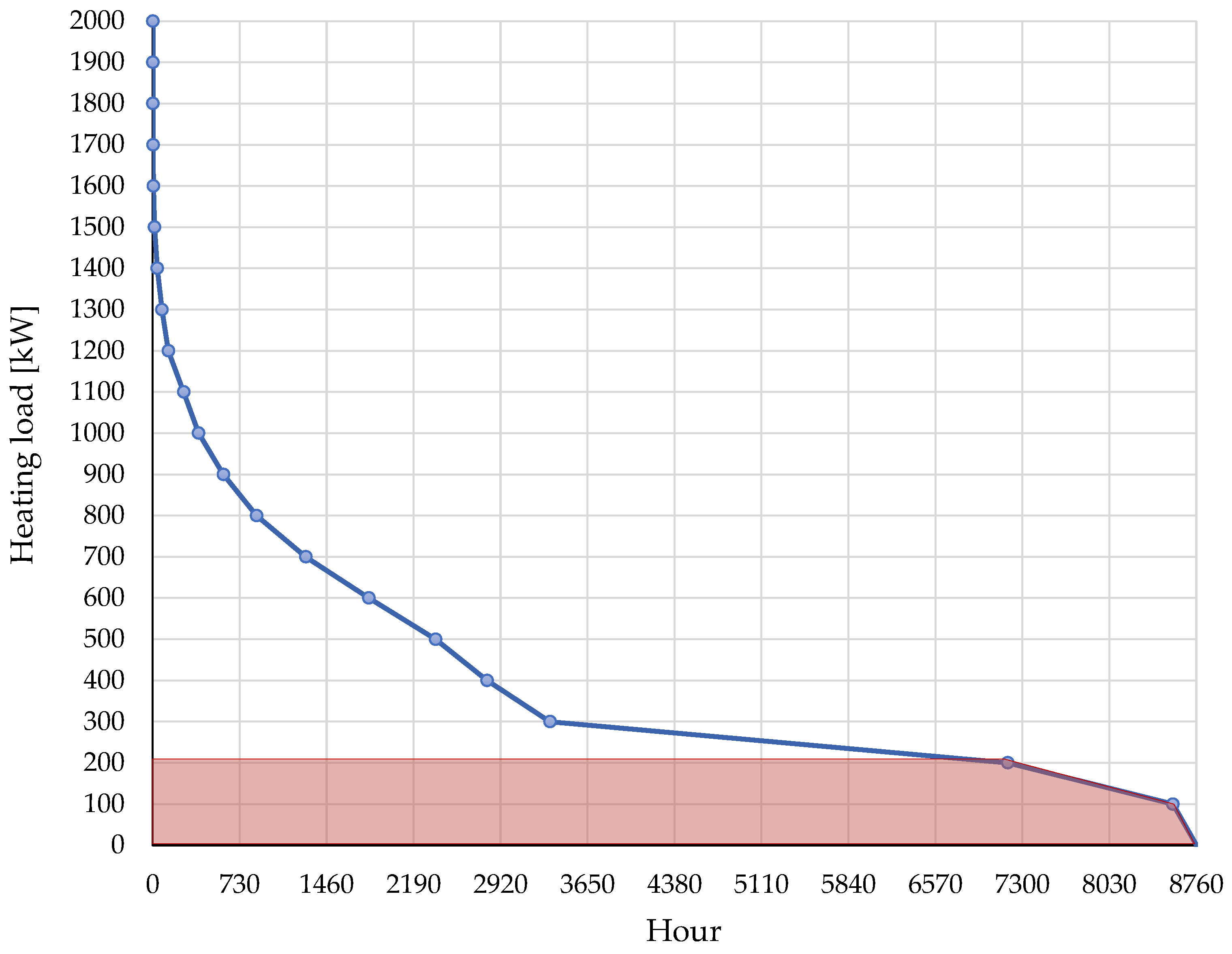

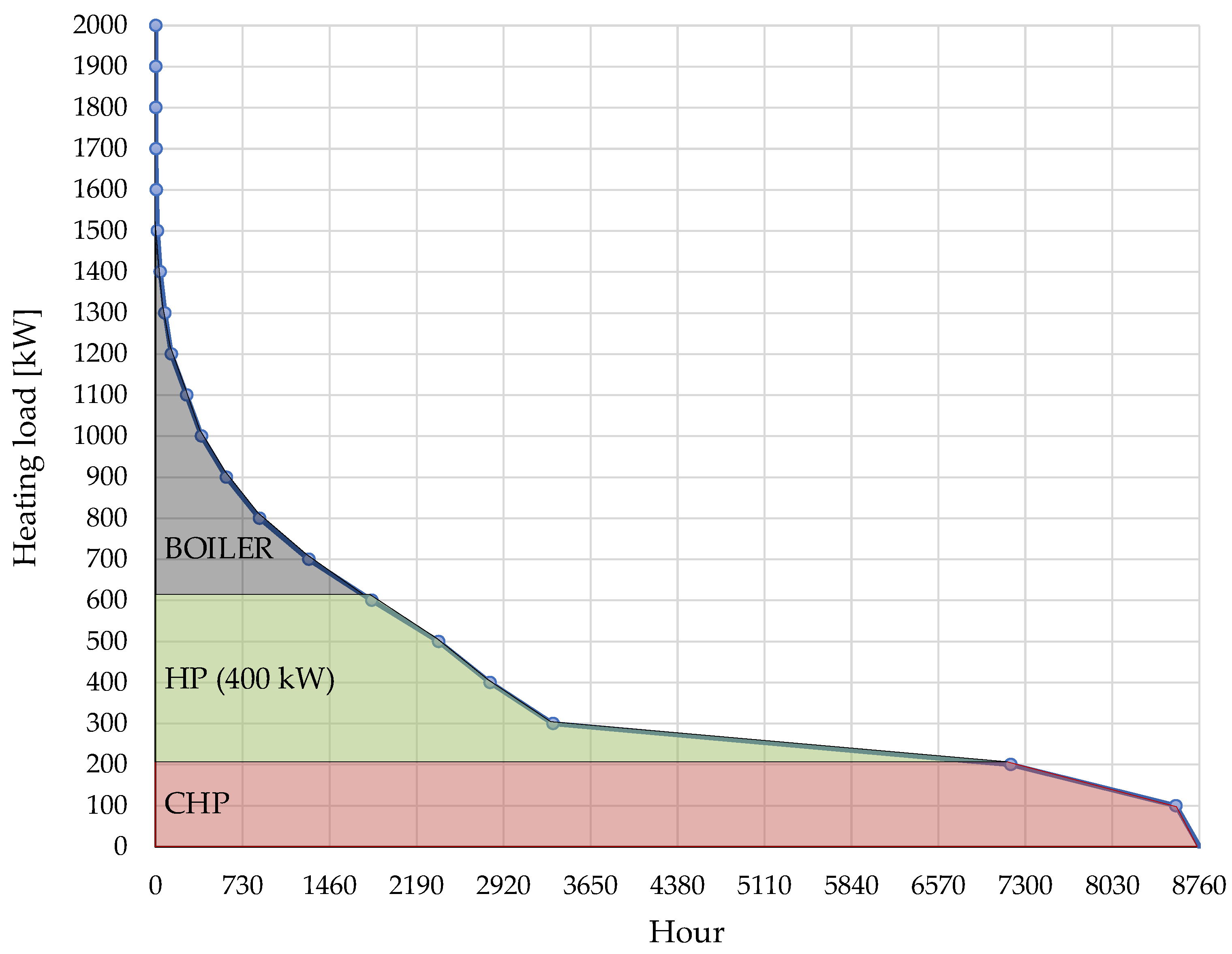
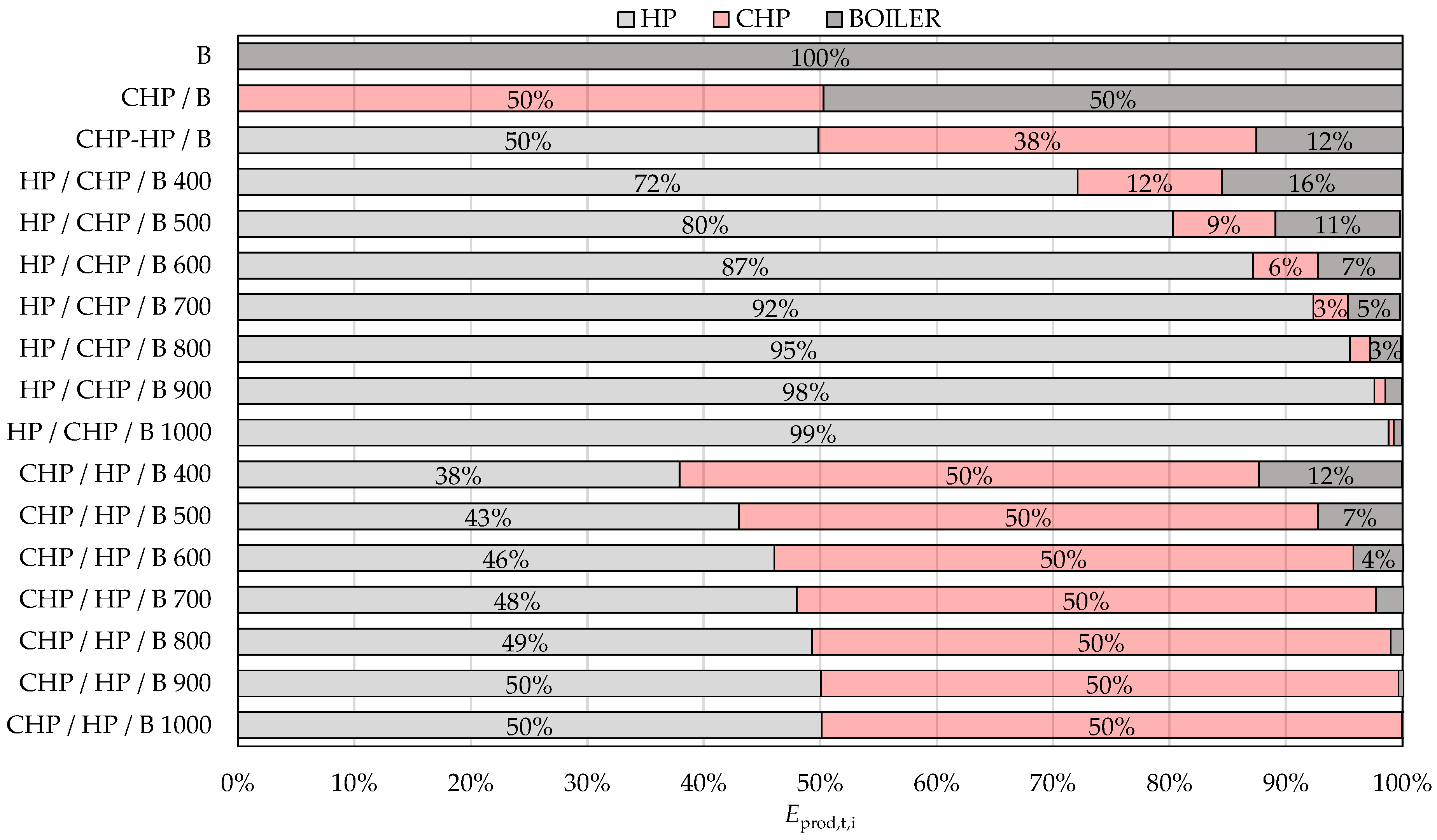
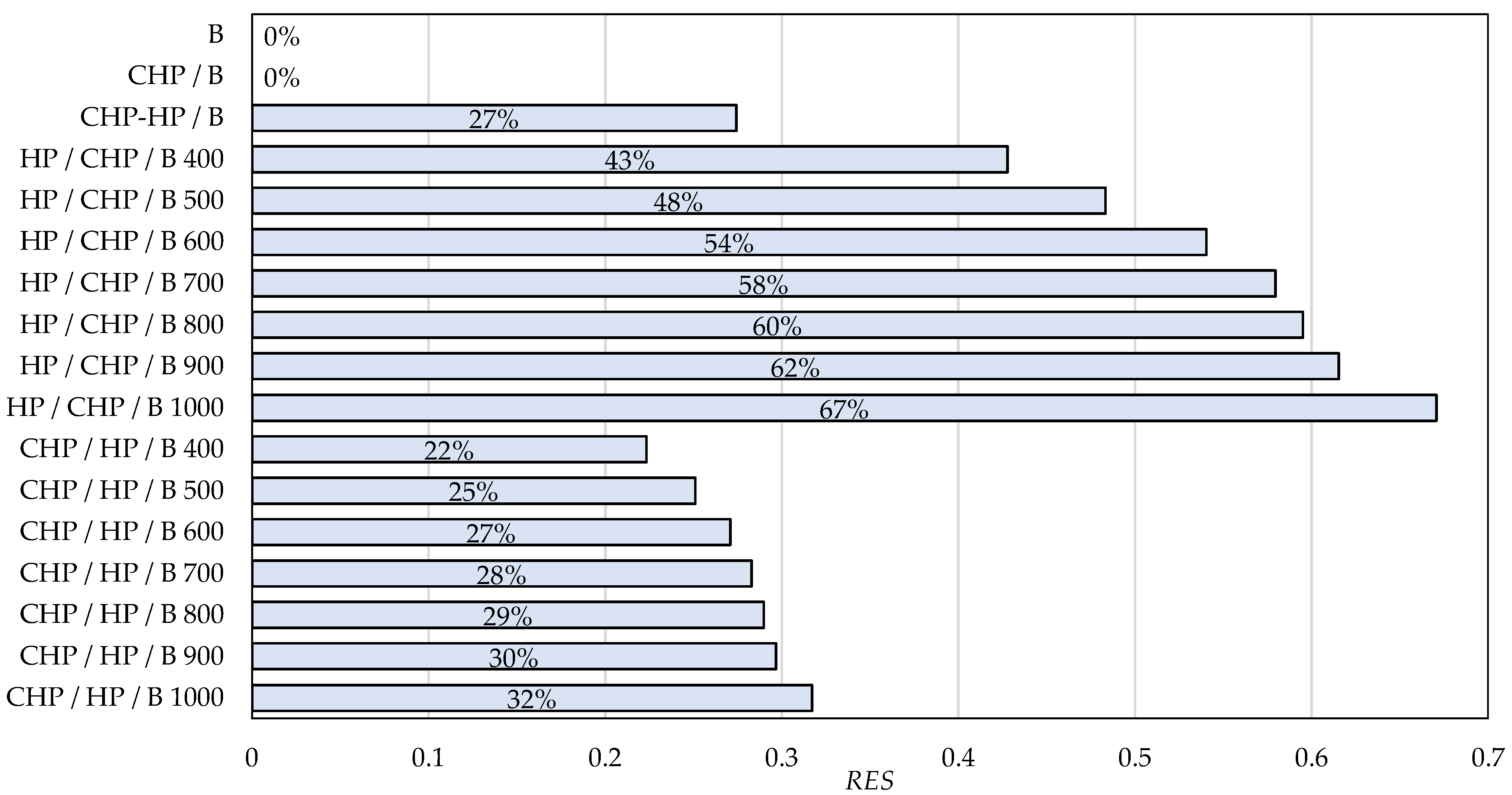
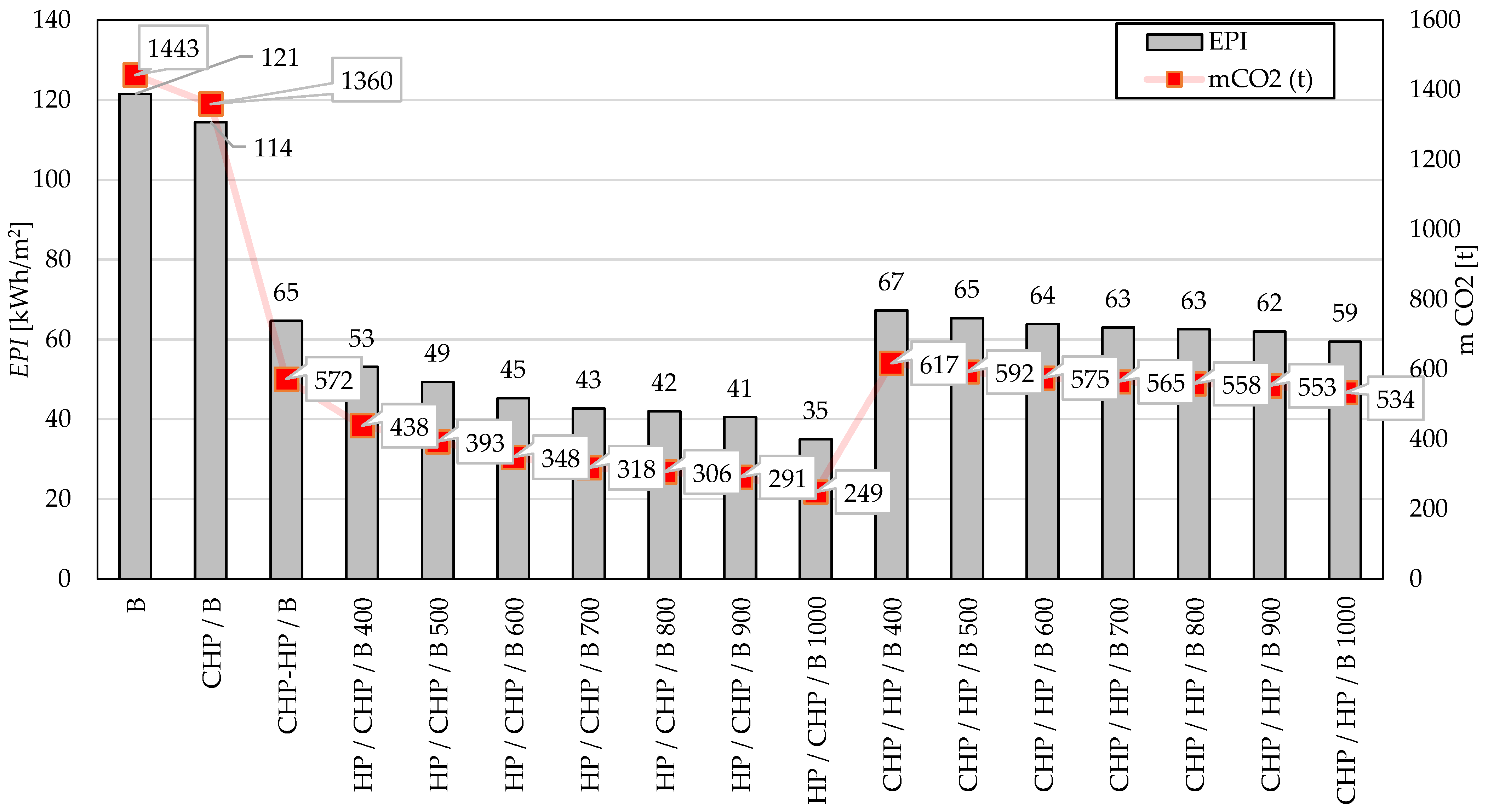


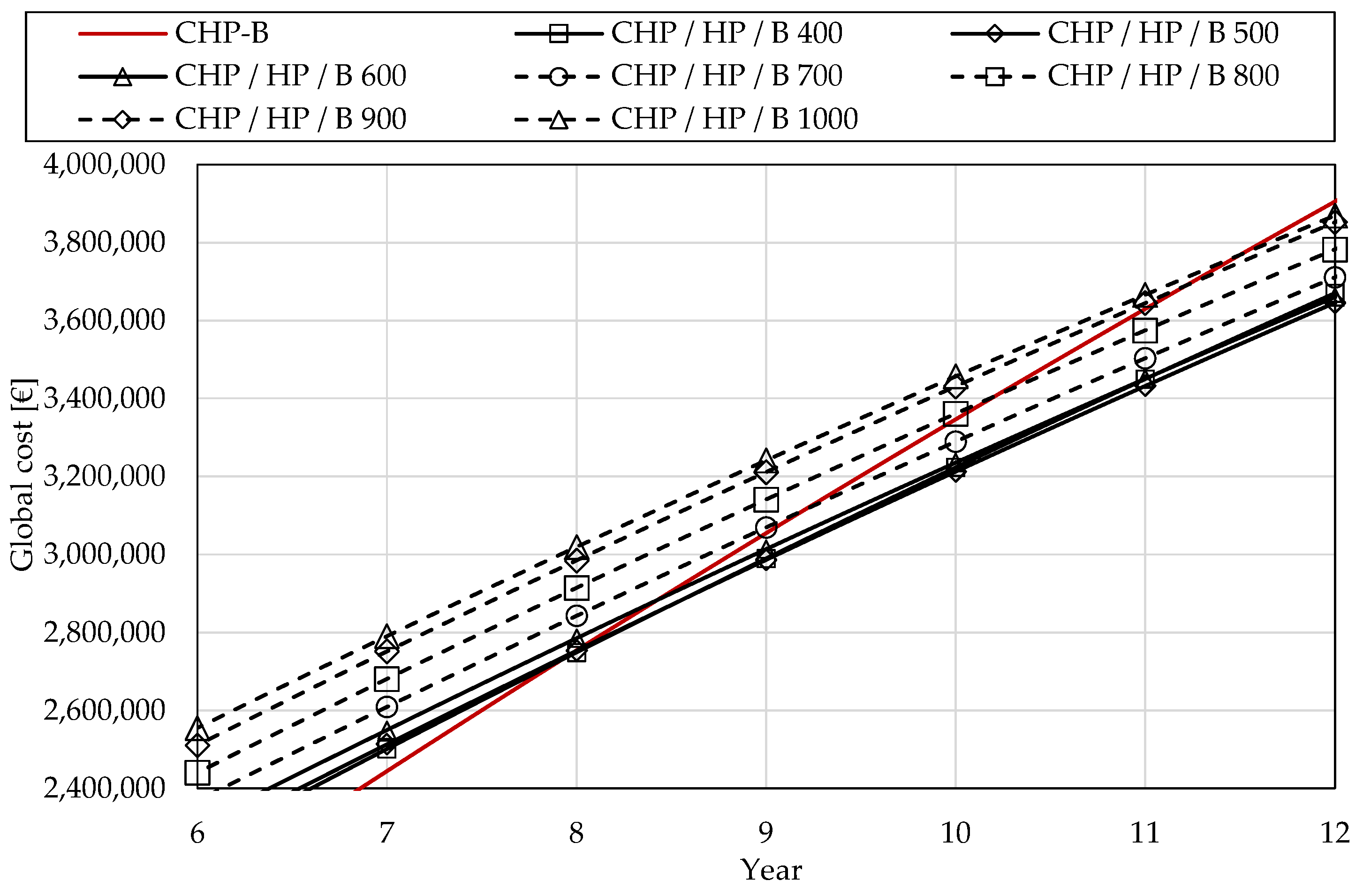
| Climate data | City | Rijeka (Croatia) |
| Longitude | E 14°26′31.834″ | |
| Latitude | N 45°19′37.427″ | |
| Design ambient temperature | −8 °C | |
| Annual average ambient temperature | 15.8 °C | |
| DH data | Trench total length | 912 m |
| Fuel type | Natural gas | |
| Annual fuel energy consumption (2019) | 5,069,863 kWh | |
| Annual thermal energy supply into DH system (2019) | 4,410,544 kWh | |
| Annual heating and DHW demand building (2019) | 3,943,144 kWh | |
| Supply/return temperature | 90/70 °C | |
| DH consumers | Number of buildings | 9 |
| Heated area | 48,455 m2 | |
| Heated space volume | 145,365 m3 | |
| Internal heat gains | 6 W/m2 | |
| Infiltration/required ventilation rate | 0.48 h−1/1.32 h−1 | |
| Heating operation | Interrupted during the night | |
| Heating temperature set point | 20 °C | |
| Number of apartments | 601 | |
| Number of persons | 1455 | |
| DHW set point | 45 °C |
| CHP Load % | Electrical Output kW | Heating Output kW | Fuel Use kW |
|---|---|---|---|
| 100 | 140 | 209 | 384 |
| 75 | 105 | 171 | 310 |
| 50 | 70 | 130 | 227 |
| System | Priority in Thermal Energy Production | HP Capacity | Electricity for HP Operation | Produced Electricity from CHP |
|---|---|---|---|---|
| B | Boiler | - | - | - |
| CHP/B | CHP | - | - | Sold to grid |
| CHP-HP/B | CHP-HP, boiler | 400 kW | From CHP | Used for HP |
| HP/CHP/B | HP, CHP, boiler | 400 kW–1000 kW (100 kW increment) | From grid | Sold to grid |
| CHP/HP/B | CHP, HP, boiler | 400 kW–1000 kW (100 kW increment) | From grid | Sold to grid |
| Scenario 1 | Scenario 2 | Scenario 3 | Unit | ||||
|---|---|---|---|---|---|---|---|
| High | Low | High | Low | High | Low | ||
| Electricity | 0.174 | 0.105 | 0.161 | 0.093 | 0.174 | 0.105 | €/kWh |
| 3.865 | 3.451 | 3.865 | €/kW | ||||
| Gas | 0.050 | 0.030 | 0.100 | €/kWh | |||
| Water | 0.013 | 0.013 | 0.013 | €/m3 | |||
| Ic | 2.8 | 4.2 | 1.4 | - | |||
| System | HP Capacity | Investment Cost |
|---|---|---|
| CHP-HP/B HP/CHP/B CHP/HP/B | 400 kW | 540,000 € |
| 500 kW | 610,000 € | |
| 600 kW | 690,000 € | |
| 700 kW | 760,000 € | |
| 800 kW | 830,000 € | |
| 900 kW | 900,000 € | |
| 1000 kW | 980,000 € |
Disclaimer/Publisher’s Note: The statements, opinions and data contained in all publications are solely those of the individual author(s) and contributor(s) and not of MDPI and/or the editor(s). MDPI and/or the editor(s) disclaim responsibility for any injury to people or property resulting from any ideas, methods, instructions or products referred to in the content. |
© 2025 by the authors. Licensee MDPI, Basel, Switzerland. This article is an open access article distributed under the terms and conditions of the Creative Commons Attribution (CC BY) license (https://creativecommons.org/licenses/by/4.0/).
Share and Cite
Požgaj, D.; Delač, B.; Pavković, B.; Medica-Viola, V. Research on the Implementation of a Heat Pump in a District Heating System Operating with Gas Boiler and CHP Unit. Appl. Sci. 2025, 15, 7280. https://doi.org/10.3390/app15137280
Požgaj D, Delač B, Pavković B, Medica-Viola V. Research on the Implementation of a Heat Pump in a District Heating System Operating with Gas Boiler and CHP Unit. Applied Sciences. 2025; 15(13):7280. https://doi.org/10.3390/app15137280
Chicago/Turabian StylePožgaj, Damir, Boris Delač, Branimir Pavković, and Vedran Medica-Viola. 2025. "Research on the Implementation of a Heat Pump in a District Heating System Operating with Gas Boiler and CHP Unit" Applied Sciences 15, no. 13: 7280. https://doi.org/10.3390/app15137280
APA StylePožgaj, D., Delač, B., Pavković, B., & Medica-Viola, V. (2025). Research on the Implementation of a Heat Pump in a District Heating System Operating with Gas Boiler and CHP Unit. Applied Sciences, 15(13), 7280. https://doi.org/10.3390/app15137280







